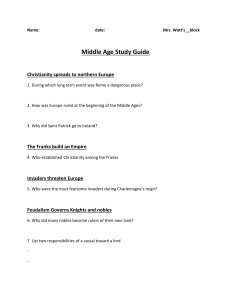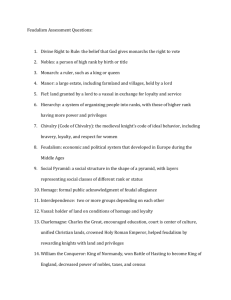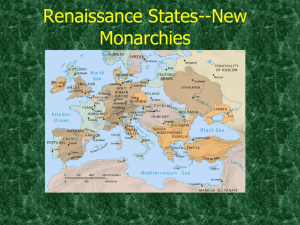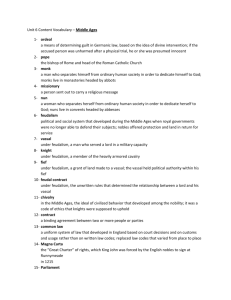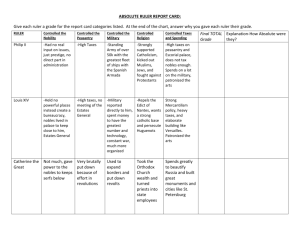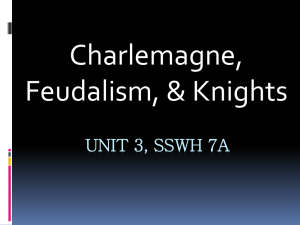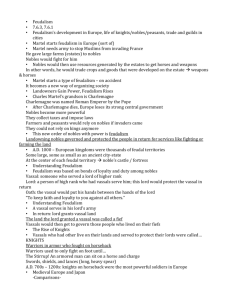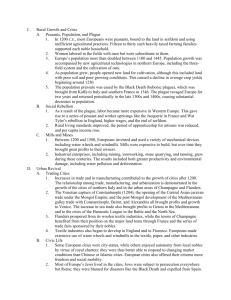Mission 1 Vocabulary sentences
advertisement
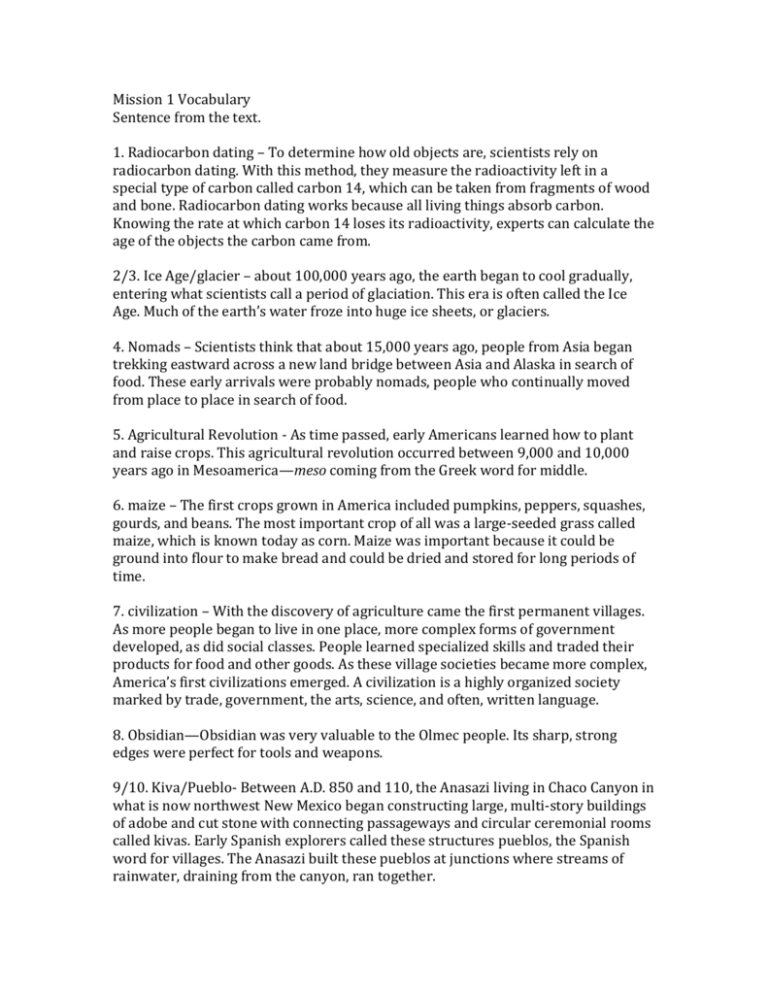
Mission 1 Vocabulary Sentence from the text. 1. Radiocarbon dating – To determine how old objects are, scientists rely on radiocarbon dating. With this method, they measure the radioactivity left in a special type of carbon called carbon 14, which can be taken from fragments of wood and bone. Radiocarbon dating works because all living things absorb carbon. Knowing the rate at which carbon 14 loses its radioactivity, experts can calculate the age of the objects the carbon came from. 2/3. Ice Age/glacier – about 100,000 years ago, the earth began to cool gradually, entering what scientists call a period of glaciation. This era is often called the Ice Age. Much of the earth’s water froze into huge ice sheets, or glaciers. 4. Nomads – Scientists think that about 15,000 years ago, people from Asia began trekking eastward across a new land bridge between Asia and Alaska in search of food. These early arrivals were probably nomads, people who continually moved from place to place in search of food. 5. Agricultural Revolution - As time passed, early Americans learned how to plant and raise crops. This agricultural revolution occurred between 9,000 and 10,000 years ago in Mesoamerica—meso coming from the Greek word for middle. 6. maize – The first crops grown in America included pumpkins, peppers, squashes, gourds, and beans. The most important crop of all was a large-seeded grass called maize, which is known today as corn. Maize was important because it could be ground into flour to make bread and could be dried and stored for long periods of time. 7. civilization – With the discovery of agriculture came the first permanent villages. As more people began to live in one place, more complex forms of government developed, as did social classes. People learned specialized skills and traded their products for food and other goods. As these village societies became more complex, America’s first civilizations emerged. A civilization is a highly organized society marked by trade, government, the arts, science, and often, written language. 8. Obsidian—Obsidian was very valuable to the Olmec people. Its sharp, strong edges were perfect for tools and weapons. 9/10. Kiva/Pueblo- Between A.D. 850 and 110, the Anasazi living in Chaco Canyon in what is now northwest New Mexico began constructing large, multi-story buildings of adobe and cut stone with connecting passageways and circular ceremonial rooms called kivas. Early Spanish explorers called these structures pueblos, the Spanish word for villages. The Anasazi built these pueblos at junctions where streams of rainwater, draining from the canyon, ran together. 11. Slash-and-burn agriculture – Many peoples in the Northeast, including the Algonquians of New England and the Iroquoians of New York, practiced slash-andburn agriculture. By cutting down parts of forests and then burning the cleared land, they were left with nitrogen-rich ashes, which they then worked into the soild, making it more fertile. 12/13. Longhouses/wigwams—The early peoples of the Northeast used several types of houses. Many villages, enclosed by wooden stockades, had large rectangular longhouses with barrel-shaped roofs covered in bark. Others built wigwams. These dwellings were either conical or dome-shaped and were made using bent poles covered with hides or bark. 14. Kinship groups – All of the Iroquoian people had similar cultures. They lived in longhouses in large towns, which they protected by building stockades. The people lived in large kinship groups, or extended families, headed by the elder women of each clan. 15. savannah 16. Matrilineal 17. Feudalism – With the weakening of central government in Europe during the time period known as the Middle Ages (500-1400), a new political system known as feudalism developed. Under this system, a king would give estates to nobles in exchange for their loyalty and military support. Eventually, the nobles owning the estates became strong enough to assume many of the powers usually held by the government. They raised their own armies, dispensed justice, and even minted coins. In return, the nobles swore an oath of loyalty and promised to provide knights, or mounted warriors, for the royal army. 16. Manorialism – The wealth of a feudal lord came from the labor of the peasants who lived on his land. Since the fall of the Roman Empire, many peasants had worked for large landowners, in part because they could not obtain their own land, and in part for protection. A lord’s manor, or estate, varied in size from several hundred to several thousand acres. Each manor included the lord’s house, pastures for livestock, fields for crops, forest and a peasant village. While feudalism describes the political relationship between nobles, manorialism describes the economic ties between nobles and peasants. 17. Renaissance – The political and economic changes that encouraged western Europeans to begin exploring the world would not have mattered had they not had the technology necessary to launch their expeditions. Fortunately, at about the same time that new unified kingdoms were emerging in western Europe, an intellectual revolution known as the Renaissance began as well. Renaissance is a French word that means “rebirth.” The Renaissance produced spectacular works of art and marked a renewed commitment to learning and science.

